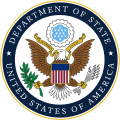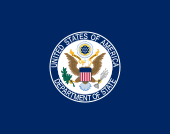| United States Under Secretary of State for Political Affairs | |
|---|---|
 Seal of the United States Department of State | |
 Flag of the United States Department of State | |
since March 22, 2024 | |
| United States Department of State | |
| Style | Mr. Under Secretary |
| Reports to | The Secretary of State[1] |
| Appointer | The President with Senate advice and consent |
| Term length | Appointed |
| Inaugural holder | Robert D. Murphy |
| Formation | August 1959 |
| Salary | $183,300 annually[2] (Executive Schedule III)[3] |
| Website | Official Website |
The under secretary of state for political affairs is currently the fourth-ranking position[4] in the United States Department of State, after the secretary, the deputy secretary, and the deputy secretary of state for management and resources. The current acting under secretary is John R. Bass, who assumed the position following the resignation of Victoria Nuland.[5]
The under secretary of state for political affairs is a career Foreign Service officer. This makes the officeholder the highest-ranking member of the United States Foreign Service. The under secretary serves as the day-to-day manager of overall regional and bilateral policy issues, and oversees the bureaus for Africa, East Asia and the Pacific, Europe and Eurasia, the Near East, South and Central Asia, the Western Hemisphere, International Organizations, and Counterterrorism. The Under Secretary is advised by Assistant Secretaries of the geographic bureaus, who guide U.S. diplomatic missions within their regional jurisdiction.[6]
The political bureaus were first overseen in 1949 by a deputy under secretary for political affairs. Prior to the creation of the position of under secretary of state for political affairs in August 1959, the deputy under secretary for political affairs assisted the secretary and under secretary of state in the formulation and conduct of U.S. foreign policy. After August 1959, the deputy under secretary of political affairs served as a focal point for interdepartmental relations, especially those dealing with politico-military issues. During 1969, the department discontinued the position and created a new Bureau for Politico-Military Affairs, which exists today as the Bureau of Political-Military Affairs under another under secretary.[7][8]
- ^ "1 FAM 041 Under Secretary for Political Affairs (P)". Foreign Affairs Manual. U.S. Department of State. January 31, 2017. Retrieved March 28, 2018.
- ^ "Pay & Leave: Salaries & Wages". Salary Table No. 2015-EX. United States Office of Personnel Management. January 1, 2015. Retrieved January 4, 2016.
- ^ 5 U.S.C. § 5312.
- ^ "Senior Officials". U. S. Department of State.
- ^ "On the Retirement of Under Secretary of State for Political Affairs Victoria Nuland". U.S. Department of State.
- ^ "Under Secretary for Political Affairs". Retrieved June 14, 2021.
- ^ "History of the U.S. Department of State". Retrieved September 20, 2007.
- ^ "Under Secretaries of State for Political Affairs". Retrieved September 20, 2007.
